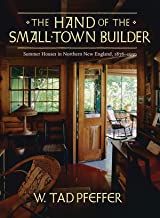The Hand of the Small Town Builder: Vernacular Summer Architecture in New England 1870-1935 by Tad Pfeffer 2014
This book caught my eye while I was reading one of my favorite books of 2022, ‘Godine at Fifty: A Retrospective of Five Decades in the Life of an Independent Publisher’. The cover, the title, and the topic all appealed to me, and the Minuteman Library Network provided this coffee-table sized volume from the Needham Library.
Pfeffer, a John Muir look-alike, is a geophysicist, teacher, and photographer at the University of Colorado at Boulder. His primary interest is in the historical imprint of people through architecture and alteration of the landscape, and in this volume he turns his attention to the cabins, cottages, and summer homes that proliferated through northern New England in the late 19th and early 20th C. Rather than focus on the great houses of Newport, RI or Bar Harbor, ME, he chose nine locations in Maine, New Hampshire, and Vermont where carpenters and builders, often working without architectural specs built human scale buildings in beautiful locations enhancing the relationship between man and nature rather than overwhelming the latter.
I was primarily interested in the beautiful and detailed photographs of the exterior and interior details built by these self-taught men, but became caught up in Pfeffer’s narrative that accompanied them. He points out that the late 1800’s was the time when these communities flourished from Boothbay and Squirrel Island in coastal Maine to Rangeley and Belgrade lakes in Maine’s interior and from Randolph, Squam Lake, and Bethlehem in the White Mountains to Greensboro, VT in the Green Mountains. He suggests that three factors led to the development of these summer communities: industrialization with its economic growth and concept of the vacation as a way of improving the health and productivity of the workers; the building of railroads that made these places accessible; and the idea of the ‘picturesque’ and the ‘sublime’ in the works of the Hudson River School painters. Spending time in a close relationship to nature, its beauty and its health-giving elements, was provided by these small town builders building human scale camps, cottages, and homes.
This book provided much more information and detail than I needed, but I couldn’t help but plow all the way through as Pfeffer provided beautiful photos and fascinating snapshots of men like John Boothman and Sylvanus Morgan and of beautiful places we’ve been but hadn’t been aware of this backstory. This is one more example of how a random glimpse of a book cover can lead to a few hours of pleasure and learning.



